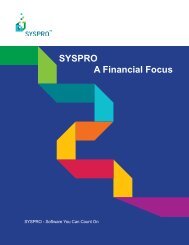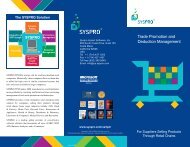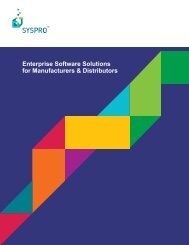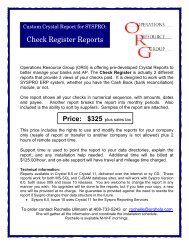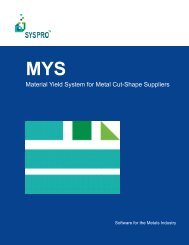Teach Yourself e.net - Syspro
Teach Yourself e.net - Syspro
Teach Yourself e.net - Syspro
You also want an ePaper? Increase the reach of your titles
YUMPU automatically turns print PDFs into web optimized ePapers that Google loves.
Remember that each class is an interface with methods that can be used to perform<br />
operations, as follows:<br />
• Query class provides methods to query data in a generic way, including:<br />
• Query.Browse<br />
• Query.Fetch<br />
• Query.Query<br />
• Query.NextKey<br />
• Query.PreviousKey<br />
• Setup class provides methods that can be used to create and modify predominantly<br />
static information contained in the database (the SYSPRO data structures).<br />
• Setup.Add<br />
• Setup.Update<br />
• Setup.Delete<br />
• Transaction class provides methods that can be used to build and post transactions,<br />
including:<br />
• Transaction.Build<br />
• Transaction.Post<br />
• Utilities class provides methods for authentication, profile retrieval and running of<br />
Net Express programs, including:<br />
• Utilities.Logon<br />
• Utilities.Logoff<br />
• Utilities.GetLogonProfile<br />
• Utilities.Run<br />
The following is a list of the variables and their definitions that we will use in this book to<br />
demonstrate and explain the classes and methods of e.<strong>net</strong> solutions:<br />
Variables<br />
BusinessObject<br />
CompanyId<br />
CompanyPassword<br />
LanguageCode<br />
The name of a SYSPRO business object to be run.<br />
Used to select a specific company, by its' SYSPRO<br />
Company id number.<br />
The password corresponding to the passed<br />
CompanyId variable.<br />
Defines the language to be used for error messages<br />
5–2





